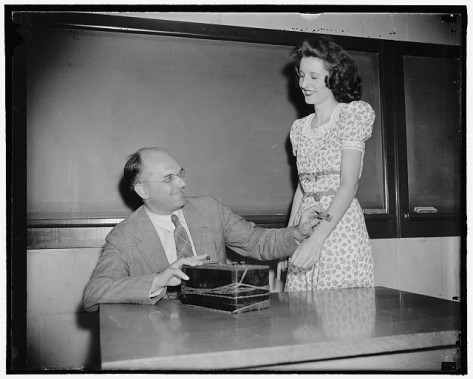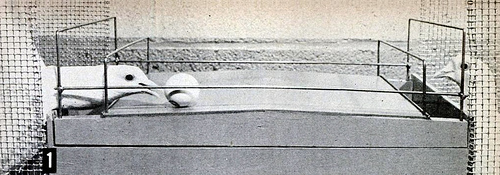Shock machines were being used at educational institutions to improve student performance long before Stanley Milgram devised his obedience experiments at Yale in 1961.
The photograph above shows a Public Speaking student, Jane Hampton, being given an electric shock by Dr. Willard Hayes at George Washington University in 1938.
Hayes used the machine to give students mild electric shocks each time they made a mistake – such as saying ‘um’ or ‘ah’ – while they gave a speech.
It’s likely that Milgram got the idea for the cover story for his own experiment from practises like these.
The cover story Milgram used for his experiment when he advertised it in the local paper was that he was looking for volunteers for an experiment about memory and learning. It wasn’t until they arrived at the lab that volunteers were told the experiment involved punishment and its effect on memory and even later before they were told the punishment involved using a shock machine.
Stanley Milgram was very proprietorial about his experiment. He was horrified to find that another researcher, Arnold Buss, has used a shock machine to measure aggression. Buss’ experiment was very similar to Milgram’s.
Here’s how Buss described it in a book published in 1961, the same year Milgram’s experiments began:
I developed a new paradigm to study aggression in the laboratory. The real subject played the role of an experimenter who used electric shock to correct the mistakes of a ‘learner’ (ostensibly another subject but in reality a confederate who never received any shock). The real subject might use so low an intensity of shock that it would not hurt (nonaggression) or a level that would hurt (aggression)…. I called it the aggression machine.
Milgram wrote to his funding body, the National Science Foundation, in September 1961, telling them about Buss’ book and how the aggression experiment was ‘remarkably similar to my own’. He went on to describe how he reacted when he read this. ‘My immediate paranoid reaction was : “tricked!”
Despite telling the NSF that he’d spoken to Buss and concluded that they had come up with the idea independently Milgram was still ‘aggrieved’ twelve years later. And he spent time in the intervening years trying to track down how Buss had come up with the idea for an experiment so similar to his own.
In a 1973 letter to his former research assistant Alan Elms, Milgram concluded that a mutual acquaintance had told Buss details of the obedience research. Milgram told Elms that this had led him to one conclusion. ‘I am now totally convinced Buss simply lifted the idea : the fink.’
Quite apart from the fact that Buss had likely finished writing his book even before Milgram’s idea for the obedience research began, the use of shock machines in psychology and psychiatry was common practise – from treatments for mental illness to use in the training of animals.
And in a strange case of truth being stranger than fiction, Milgram’s cover story has received support with recent research concluding that shock therapy can indeed improve learning.
Pigeon ping-pong image credit : all-about-psychology.com






Comments are closed.